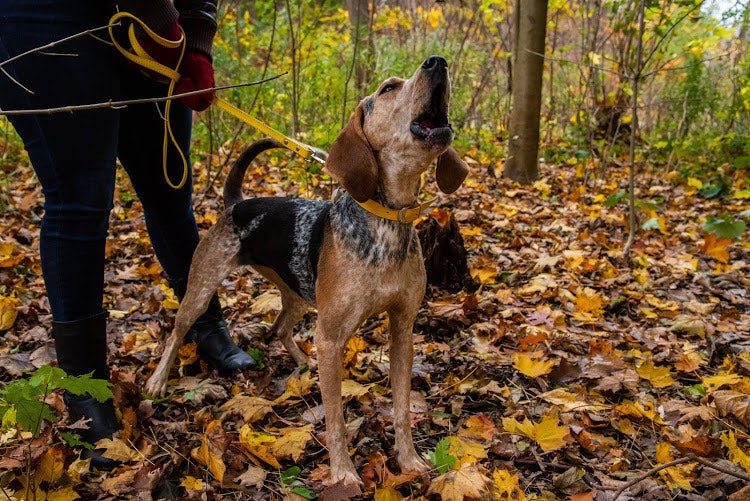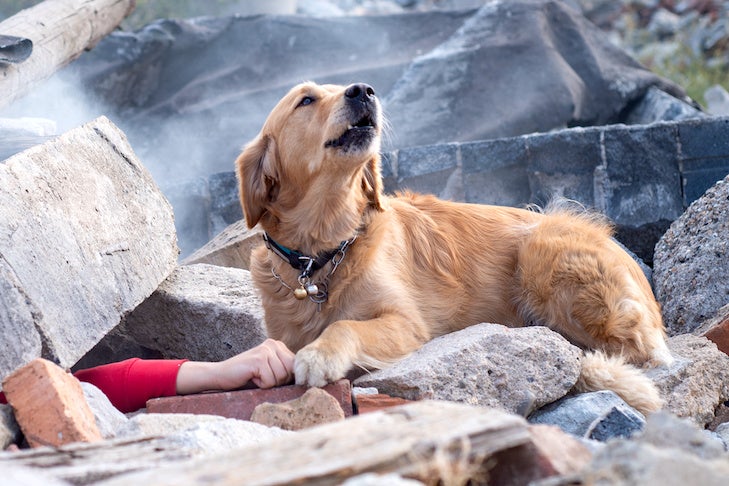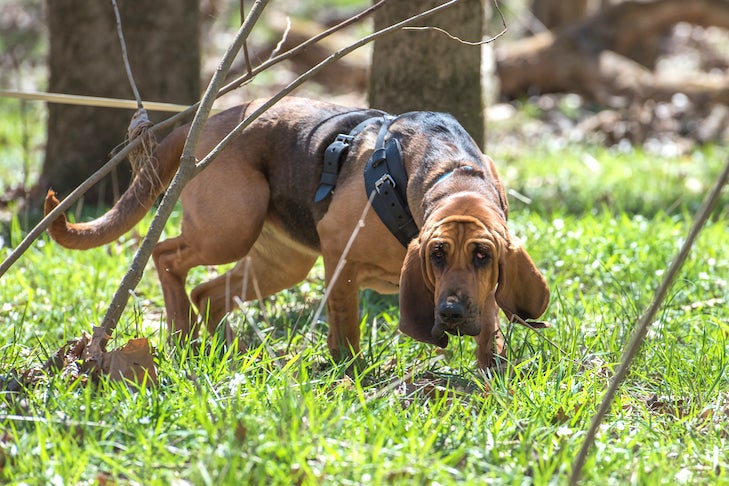
Search-and-rescue volunteers know that when the phone rings in the middle of the night, it is likely to be a call to action — a request for them and their dogs to pack up their gear and trudge out in any weather to assist in the search for a missing person. Such was the case one Sunday in May, when Larry Bulanda, a search-and-rescue volunteer in southeastern Pennsylvania, heard the distant ringing of the phone in his sleep.
The call was from the Phoenixville, Pa., fire department, saying that several hours earlier a 13-year-old boy was reported missing from his home. As Larry and his wife, Susan, quickly threw on some clothes and alerted their two dogs, Susan glanced at the clock. It was just after 4:00 a.m. They would have to move fast, as the weather was unseasonably cool, and a storm was approaching.
After arriving at the boy’s suburban home, a quick interview with his parents alerted the authorities and volunteers to the fact that the parents had had a disagreement with the boy and he had run away. The Bulandas’ veteran search-and-rescue dog Scout was given a scent article belonging to the boy and immediately found a track. Scout followed the track down the driveway to a paved road, where he led the search team for about half a mile. At that point, Scout veered off the road and went behind two houses, circled back out to the road, and lost the scent.
The search-and-rescue team returned to base — the parents’ house. At this point, the Bulandas’ Border Collie, Ness, was taken into the woods around the house, where the police and fire departments reported having heard noises during their earlier search effort. Within 15 minutes, Ness pulled and yanked Larry to the boy, who was hiding in the brush, trying to evade capture. When Larry saw the boy hiding in the brush, the boy tried to run off. Larry had to grab the boy and escort him back home.
The boy sheepishly told everyone that he had been slipping from bush to bush to avoid being found. With a logic that perhaps only a teenager can truly comprehend, the boy decided to stay hidden when he saw all of the commotion — including police officers, fire trucks, and search-and-rescue dogs — and he was certain that he would get into more trouble with his parents than he already was.
He may have evaded all the people searching for him, but he could not escape a well-trained dog’s nose.
The Cost of Search and Rescue
Not all searches, of course, end so well. The Bulandas have been working canine search and rescue (SAR) for more than 20 years. (Susan is also an author and ethnologist specializing in animal behavior, and Larry is an engineer at Lucent Technologies.) Their dogs have looked for everyone from murder victims to casualties of an East Coast tornado. Dogs often succeed where humans cannot, and the statistics of successful finds by SAR dogs are impressive.
Canine search-and-rescue efforts have existed for decades, starting with the military’s use of dogs to search for war victims. But it was the 1995 bombing of the Alfred P. Murrah Federal Building in Oklahoma City that cemented in the minds of most Americans the image of handler and canine doing this type of work together.

Although individual volunteers like the Bulandas conduct search and rescue across the country, the federal government also employs SAR dogs and handlers as part of the Federal Emergency Management Agency (FEMA). After the Oklahoma City bombing, the National Disaster Search Dog Foundation was created with the goal of increasing the number of teams of certified disaster-search dogs and highly trained handlers by 300.
The financial cost to the volunteer handlers can be heavy, with some estimates putting the average at $5,000 or more per year. In the face of these significant costs, and because the handlers must first learn to train dogs, it takes most handlers several years to train a search-and-rescue dog, according to the foundation.
SAR work is at times grueling and dangerous for both humans and animals. Aside from the physical dangers, the dogs often pick up on the stress of the situation and show signs of depression. In Oklahoma City, for instance, many handlers staged scenes at the end of their shifts where a co-searcher would be “found” by a happy SAR dog in order to give the dog a feeling of accomplishment.
Human SAR workers often suffer from depression, too. It helps, volunteers say, if both partners work in SAR or if the partner is employed in a similar profession, such as emergency medicine.
Cadaver Dogs vs. Live SAR
There are two primary disciplines (“live” or “dead”) to choose from when training for K-9 SAR.
“Live” training involves either tracking/trailing or air-scent dogs. Tracking/trailing dogs, or scent-specific dogs, are trained to follow the unique scent of an individual. Tracking or trailing dogs is done on a long line with the handler following the dog on the track.
The other “live” discipline is air scent, or area search. This requires the dog to cover large areas quickly, off lead, quite some distance from their handler. An air-scent dog samples the air currents for the scent of any human, follows it to the source, and reports back to the handler. These teams are often called wilderness search teams because the style is suited to large tracts of unpopulated land.
Dogs who have trained for “dead” work, or human-remains detection (HRD), are also called “cadaver dogs.” They use primarily air-scent methods to search for the scent of human decomposition, to the exclusion of all others, eventually pinpointing the source and alerting the handler.
Usually, a dog and handler will specialize and certify in one discipline or the other — not because the dogs can’t do both well, but to avoid confusion in findings in criminal cases.
What Dogs Make Good Search-and-Rescue Dogs?
SAR dogs search by sniffing the air and can pick up a human’s scent from as far away as a half-mile, and sometimes farther. Dogs that perform water searches have been known to catch the scent from 1 1/2 miles away. Breeds that excel at SAR include Border Collies, Bloodhounds, German Shepherd Dogs, Golden Retrievers, Labrador Retrievers, and, in some cases, Schipperkes, but almost any medium- to large-sized working or sporting breed that doesn’t suffer from separation anxiety when away from their handler can be up to the challenge.
For fun, Susan even trained her Havanese puppy in the finer art of SAR. The dog got gold stars but was too small for such grueling work. A necessary factor for SAR work, says Susan, is that the dog must be able to work independently. In addition, the dogs must be people-motivated rather than game-motivated.
For instance, in Great Britain, some Border Collies must pass a “sheep test” before they can be SAR dogs. The test involves the dog sitting in one place while a herd of sheep is driven around them on all sides. The dog must ignore the sheep, a tall order for a breed with such a strong herding instinct. But passing this test is the only way the handlers can trust the dogs to perform SAR work without being distracted.

“Dogs must be able to think on their own,” says Susan. “Because we cannot possibly train a dog for all of the situations that come up, they must be able to generalize and apply the training they have had to a new situation. When the handler is wrong, the dog must let the handler know that is known as ‘intelligent disobedience.'”
A dog that might do well in obedience, agility, and tracking events may not excel at SAR. While there are cases of dogs that win in the ring and are outstanding at SAR, they are rare. “When you take an obedience-trained dog and ask him to do something on his own, he usually will not do anything without handler direction,” says Susan.
“SAR dogs have to work with the handler as a team, to not be blindly obedient to the handler,” she continues. “If the dog knows there is scent in one direction and the handler directs the dog to another area, the dog must insist that the handler is wrong and indicate by the trained signal that there is scent here, not there.”
In addition, obedience-trained dogs often perform exercises in controlled conditions. But nothing is controlled for the SAR dog. “There are never prescribed conditions. Actually, conditions change all the time,” says Susan.
Finding Bodies
Conditions did indeed change in the case of a search involving a father of four. The man disappeared with his eldest son when their canoe flipped over in a Pennsylvania creek. The son’s body was found upstream, but it was more than two months until the father’s body was found, 10 miles from the spot of the accident. Bulanda and other volunteers and their dogs had searched different areas of the creek and adjoining river, from the grassy banks to a small dam, with no results.
Handlers know the dog has a “hit” when their body language changes. This is often followed by a “trained alert,” which could be barking, whining, or, in some water searches, biting at the water, says SAR volunteer B. Diane Whetsel. Whetsel co-founded Search Dogs Southwest, a volunteer group that works with fire and police departments and FEMA. She has found herself working everything from a hurricane (her canine partner, Hershey the Labrador Retriever, went into semi-retirement after hurting his back searching through wreckage left by Hurricane Opal in the Florida panhandle) to assisting the local police force on a homicide case.

SAR workers are remarkably nonchalant when discussing cadaver searches. But they point out that they must remain calm and collected under pressure — especially in the face of the many unpleasant aspects of their work. This can be difficult when dealing with a family that is observing the search for a loved one.
For instance, Whetsel and her dogs were called into a small Florida town after a young child with autism disappeared from his family’s hotel room during a family reunion. The canal in the back of the hotel had been searched by divers, but with poor underwater visibility, the divers came up empty.
The dogs, walking up and down the canal, kept getting a hit at a certain point. Every time they did, they barked and had to be rewarded by the handlers — in this case with play — and it was obvious to the family that the dogs detected the boy’s body. “It was upsetting to us and to the family that the dogs knew the child was underwater and most likely dead,” Whetsel says. The body turned up later that afternoon, 5 feet from where the dogs alerted.
SAR volunteers warn prospective searchers that this is not an activity for just any person or dog. According to Susan, the conditions are often terrible, the hours are usually bad (searches seem to never happen at convenient times), and searchers are always on call. But the hard work pays off for the volunteers, whether human or canine, as they provide an invaluable gift to families in need.

